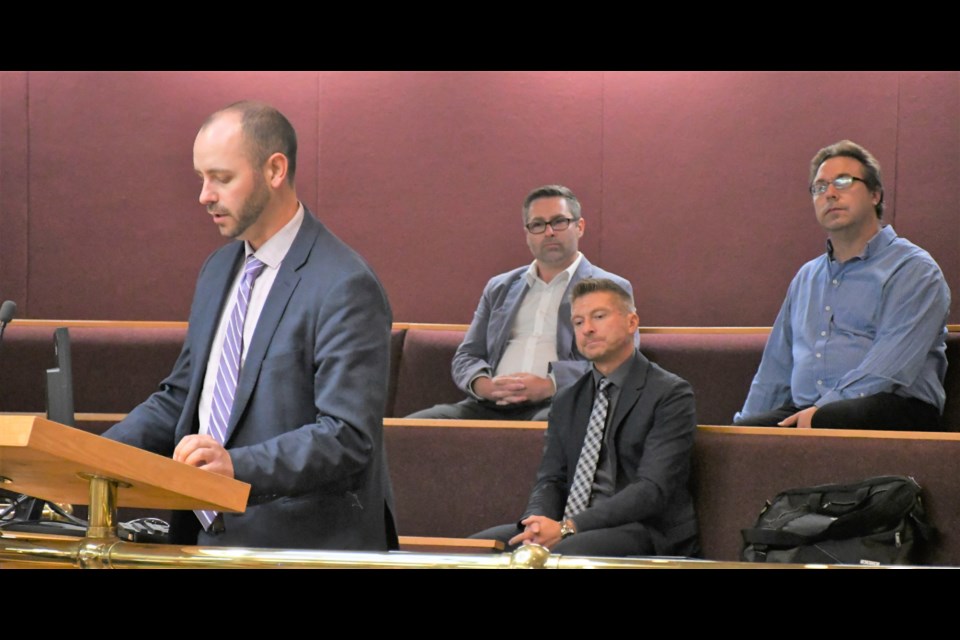The location of the proposed joint-use school on South Hill concerns some city councillors, particularly since it contradicts the Official Community Plan (OCP) and pushes the municipality’s footprint further west.
Councillors discussed the project during their Sept. 8 regular meeting, after hearing from an official with the Ministry of Education — accompanied by representatives from both Moose Jaw school divisions — about an agreement that the ministry and city administration had hammered out. The document lays out the requirements to locate a joint-use school within the Westheath neighbourhood.
Council voted 6-1 to accept the agreement; Coun. Brian Swanson was opposed.
Traffic assessment
The ministry plans to complete a traffic impact assessment (TIA) since there is concern about traffic issues there, explained Rory Jensen, acting assistant deputy education minister. When the ministry has the results by Sept. 25, it will discuss the assessment with city administration. If mitigation strategies are required to address traffic issues, the ministry will cover the costs.
Once the ministry and school divisions develop options to locate the school on the Westheath site, it will engage in public consultations by holding town hall meetings to ensure the community’s voice is heard, Jensen told Coun. Crystal Froese. The meetings would focus on the site location, the location of roads, and residential configurations, but wouldn’t be about the actual building design.
New subdivision needed
This is a good location since South Hill is already landlocked, said Coun. Heather Eby. She thought it would be great to build a new school in the middle of the area, but there is no existing space unless buildings are knocked down and blocks bulldozed. The municipality might not need a new subdivision today, but it does need a new school on South Hill.
“If we are going to be obstinate, we will lose this project … ,” Eby said. “I look forward to the day when we have a grand opening and I can see my grandchildren start their first day in a new South Hill School.”
Eby also appreciated how the city wouldn’t have to deal with the repurposing or demolition of the four elementary schools once the new school is built.
New school long overdue
It’s right that council wants a new school since one is overdue in that area, said Froese, who didn’t think the ministry would take away the project simply because council had concerns.
However, she also disapproved of the Westheath site, since it violated the OCP and is located where there is little room for infill or growth. While the school’s construction would develop some empty lots, it would not service the central parts of South Hill.
“I’m hopeful that this will go really smoothly and be expedient … . Students have been waiting for a new school,” she said.
Froese also hoped that there was solid communication on this project and more public engagement since this was a “generational project” of $50 million.
Besides this $50-million project, SaskPower also intends to build a $700-million power plant, Mayor Fraser Tolmie pointed out. While it is disappointing that building permits have declined and the pandemic has been an outside factor, the real estate market is taking off again.
Residents are looking for council to build confidence in the local economy, so supporting this project does that, he continued. While he hoped society could overcome the pandemic, he didn’t want to wait around and not have plans in place or be unprepared for the future.
Location a surprise to city
The location of the proposed school was a complete surprise to the city when the school boards made the announcement since there was no discussion with city hall, said Swanson. Furthermore, the subdivision there exists only on paper.
Council told the school divisions that it was not interested in developing that subdivision right now, but if that was their desired location, then they had to develop the site themselves and not leave taxpayers responsible for costs, he continued. Only one company expressed interest in developing the site, but officials at city hall and the ministry rejected the proposal as inadequate. This means taxpayers would likely be responsible for developing the subdivision.
“That is my concern here. We are going to get into a subdivision that I don’t think is justified at this time,” said Swanson, who is also a trustee with Prairie South School Division.
Council received building permit numbers recently, which showed there were 10 new housing starts from January to August, compared to 20 new starts during the same time last year, he continued. This shows a subdivision is unnecessary right now, while council would have to spend plenty of money in hopes of recouping those costs through lot sales.
In comparison, he noted that Humboldt and Weyburn have more housing starts than Moose Jaw.
City expands further west
Swanson’s second — and larger concern — was the development expands the city’s footprint further west when there is virtually no population growth and few housing starts. He thought this was bad urban planning that would have long-term consequences, while the traffic impact assessment was a distraction from this concern.
There are other, less expensive sites for the school, including one that was always in the municipality’s Official Community Plan (OCP), he continued. Even city administration says the proposed site contravenes the plan.
Council spent $300,000 on a concept plan for Westheath, but with the ministry creating its concept plan, Swanson thought council had essentially wasted money.
Money not wasted
City manager Jim Puffalt pushed back by saying the money was not wasted since the ministry plans to provide two other concept plans. Further, there wouldn’t be urban sprawl since the ministry is adding to existing streets and not skipping around the subdivision.
“The ministry had apologized constantly about not consulting us … ,” he added. “There will be no cost to taxpayers because the ministry will pay for (the development).”
The next regular council meeting is Monday, Sept. 21.




